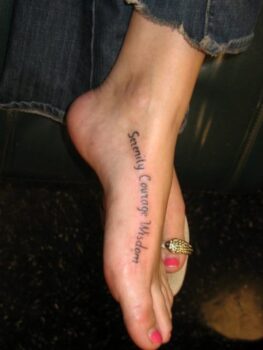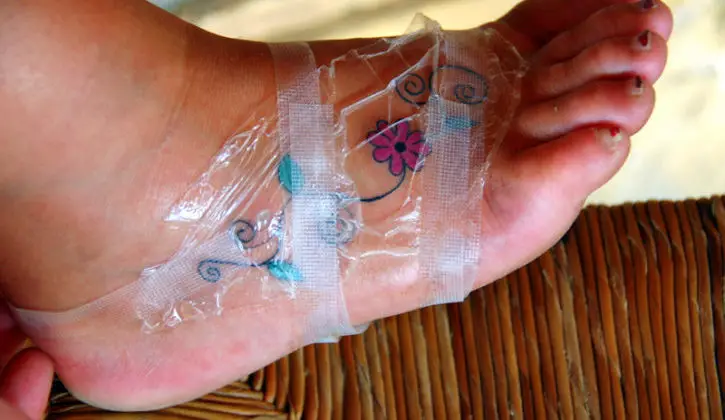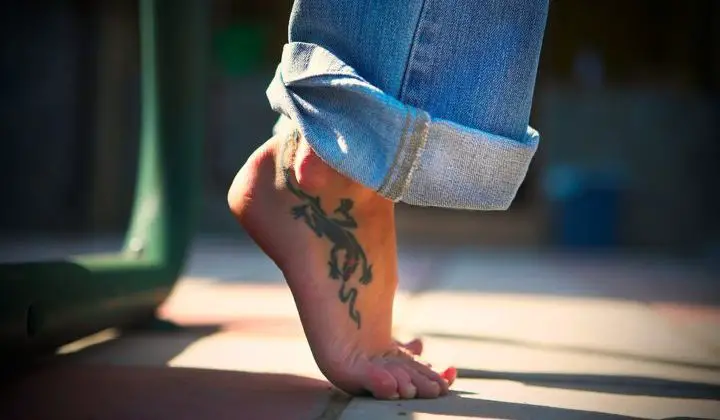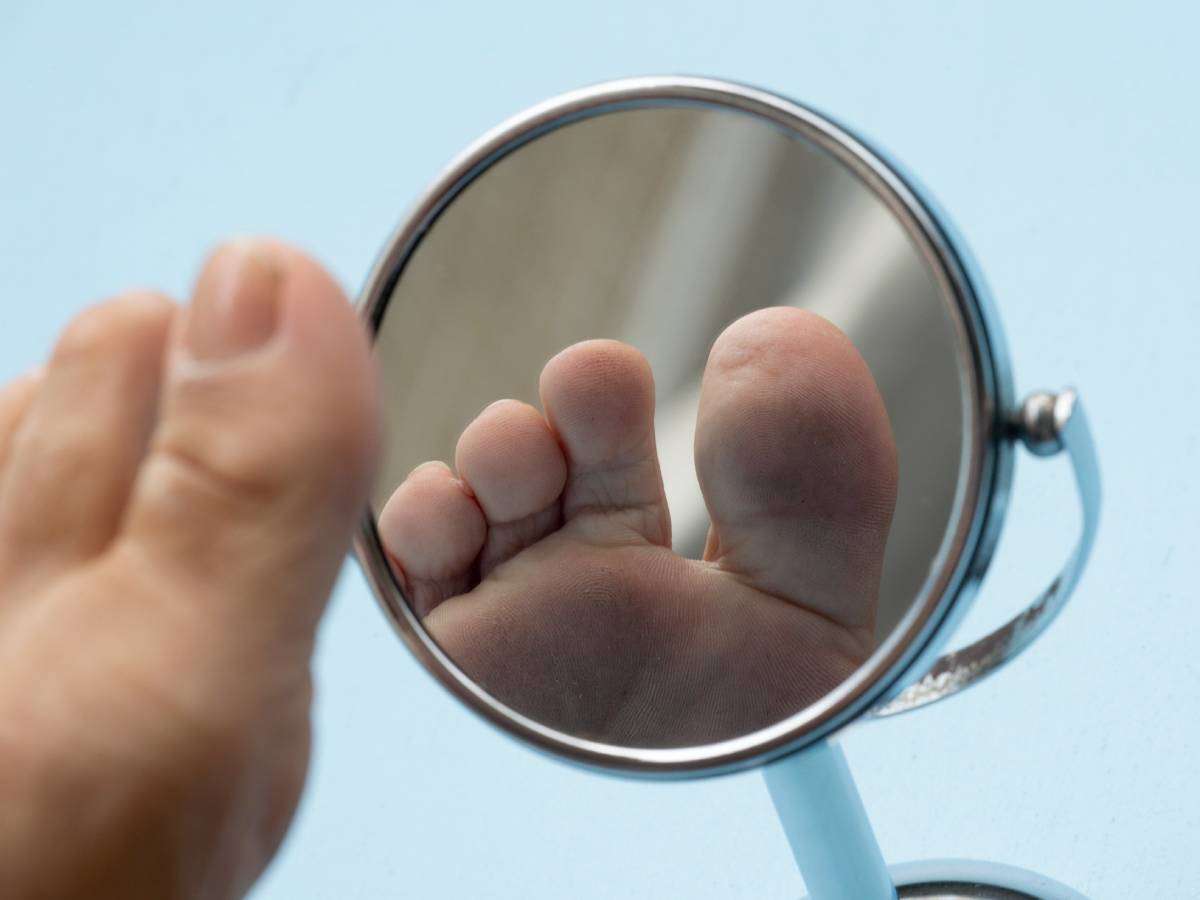Foot tattoos seem to be all the rage lately — everyone wants one!
Myself included — I’ve even been keeping a Pinterest board of my favorite tattoo designs.
While tattoos that are tasteful can look really nice and make you feel attractive, I’ve discovered a few reasons to possibly reconsider getting a tattoo on your foot.
If you’re torn between getting a foot tattoo and putting your tattoo somewhere else on your body, these facts about foot tattoos may help you decide…
#1 – The pain
There is almost no muscle on your feet. In fact, it’s pretty much just skin on top of bone — particularly on top of your foot. Because of this, getting a foot tattoo can be extremely painful.
Be prepared for more blood and possibly pain during tattooing. There are many nerve endings and capillaries in your feet and not much cushioning between the skin and bones. This can make foot tattoos more painful than tattoos in other places, and the added capillaries can cause a greater amount of bleeding. The more you bleed, the higher the chance you will bleed out any color applied to the tattoo. Also, if you don’t keep the area clean throughout the healing process, it can cause infection and scarring. Both can prolong healing time and affect the finished product.
—Source
Some people even put foot tattoos on the bottom soles of the foot. This too, is incredibly painful.
If you are someone who cannot tolerate pain well, then it’s probably a good idea to put your tattoo somewhere other than on your foot.
I happen to have a high pain tolerance. (I’ve been told this many times — from massage therapists, doctors, and surgeons.) So the pain itself isn’t deterring me at this point.
Foot tattoos can definitely be very painful, but on the other hand, lots of people also advise that getting inked on the feet isn’t as bad as others describe. Obviously however, amounts of pain will always vary from person to person.
—Source
Here is the Tattoo Pain Scale for every area of the human body.
#2 – The limited space on your foot (the tendency for foot tattoos to blur)
Since there’s not much space on your foot, you won’t be able to get a very large tattoo or a very detailed tattoo. (Fine in my case — because I’m only considering a small but meaningful foot tattoo.)
Also, keep in mind that tattoos on the foot are more likely to spread and blur — which is another reason that choosing a large or detailed design isn’t such a good idea.
Technically, tattoos becoming blurry over time is referred to as ink migration (or a blowout). The parts of the body where ink migration or blowout is most likely to occur include:
- Ankles
- Fingers
- Toes
- Tops of hands
- Tops of feet
- Wrists
So, if you’re thinking of getting a foot tattoo that is either very large or very detailed, you may want to consider put that tattoo somewhere else on your body instead.
#3 – Some tattoo artists won’t put tattoos on feet.
Because of item #2 above — and how perfectly a foot tattoo must be placed, some tattoo artists will not do foot tattoos at all.
For the most part, they simply don’t want to be responsible if your foot tattoo becomes blurry, or if there are problems with infection — because those are 2 things that are hard to eliminate with foot tattoos. (See item #3 below.)
Foot (and hand) tattoos are difficult to do well. To understand why, consider the nature of a tattoo. The ink is liquid, of course — but you might not realize that it remains a liquid, expertly positioned between the epidermis and the dermis. It neither sits on top of the skin nor gets absorbed. The feet and hands have thinner skin than the rest of your body, and positioning that ink just right takes skill and practice. Just a smidge too deep or too shallow, and you’ll wind up with a blurry or discolored tattoo that screams “mistake” — and it’s one that even the most expert artist can make. Even if your tattoo turns out perfectly, it’ll be very difficult to maintain. Your hands and feet take a lot of abuse in everyday life, and all of it can nudge that pocket of ink out of place.
—Source
#4 – A foot tattoo can take 2 to 3 weeks to fully heal.
And even then, it’s not a guarantee that the skin where the tattoo is won’t get infected.
You have to be very careful to keep a foot tattoo clean and sterile — which can be a drawback, especially if you work at a job that requires you to wear closed shoes.
Getting to the healed point for a foot tattoo is difficult and tricky … Foot tattoos are all too easily infected, and sunlight (because it penetrates skin layers) can wreak havoc. If you really want to get that foot tattoo, you must be totally prepared to baby it like you have never babied your skin before..
—Source
This is the most thorough guide for healing after any tattoo that I have found. And here’s another honest, and upfront guide showing how to care for a new tattoo that is helpful.
#5 – It can be difficult to hold still while getting a foot tattoo.
The foot is a very sensitive area. Similar to when you hit the area below your kneecap and your leg automatically kicks out (like they do at the doctor’s office to test your reflexes) — the same is true with areas of your foot. Hitting certain places on your foot can sometimes elicit an uncontrolled reaction… or natural reflex.
Even if you’re doing your best to hold still, there may be instances when the tattoo artist is doing the work and you make involuntary movements.
Unfortunately, if you flinch and cause the art to get mucked up, it may not be able to be fixed — which could mean that you are stuck with a crummy looking tattoo on your foot for many years.
In spite of your best efforts to keep still while getting a foot tattoo, your foot may engage in some twitching and jerking, and the tattoo artist may have difficulty controlling the needle when it does. If the tattoo artist is good enough, he or she may be able to cover up any resulting squiggles, but that’s a chance you’ll have to take.
The Bottom Line…
In the end, I love the way tattoos look when they are done tastefully and by a good tattoo artist. Several of my friends have tattoos, and I have absolutely nothing against tattoos themselves — on feet or in other places.
I am still considering getting a foot tattoo, but honestly — I’m in no rush to do so at this time.
I guess I’m mostly worried about the foot tattoo becoming blurry over time, and having to redo it or completely tattoo over my original foot tattoo (a process I’m not sure I want to do once… let alone twice). In fact, removing a tattoo often requires repeated treatments.
I’m also nervous about flinching during the inking process — just like I do when I’m having a pedicure. It’s completely uncontrollable. I can tolerate a good deal of pain, but I can’t seem to tolerate simple touch on my feet as well as I’d like to.
And the bottom line is I don’t want to end up with a foot tattoo that I don’t like.
The right foot tattoos tend to look really cool. And I have mad respect for anyone who gets one done! It’s up to you (and me) to thoroughly weigh the advantages and disadvantages for ourselves before getting one.
Some takeaways:
- Before you get a foot tattoo, be sure to check out these videos of other people getting tattoos on their feet first — so you’ll have a good idea of what it’s really like to get a foot tattoo.
- See how much it costs to get a tattoo.
- And here’s how much it costs to get a tattoo removed — if you end up not liking it.
1 in 10 people who get tattoos experiences problems with the tattoo. “I’m not anti-tattoo at all. I happen to think tattoos are beautiful,” safid study co-author Dr. Marie Leger, a dermatologist at the New York University Langone Medical Center in New York City. But people should know that “there are certain risks.”
—Source
Did You Know?…
- Green and blue pigment tattoo inks are the safest for ink — because they are made from copper salts. (The FDA has approved copper salts for use in contact lenses, paint, and surgical implants.)
- Red, pink, and purple pigment tattoo inks are the most likely to cause allergic reactions — due to the cadmium and mercury they contain. In fact, red dyes are responsible for chronic reactions that tend to last more than 4 months.
- People who choose ankle and foot tattoos are usually more mysterious and introverted. Since the foot area is so small, foot tattoos tend to be very simple and carry a large meaning.
- Toe ring tattoos tend to fade more quickly than tattoos in other places — because the skin gets moist anytime you’re wearing socks and shoes, which naturally causes your skin to slough off each time.








